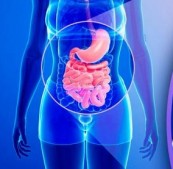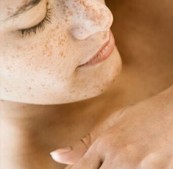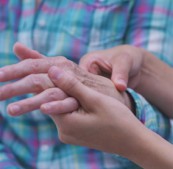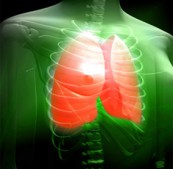Psoriasis

Psoriasis is a long-lasting autoimmune disease characterized by patches of abnormal skin. The term Psoriasis originated from the Greek word "Psora" (spelled sora) that means, "itch". It is a chronic skin disease characterized by dry skin and raised, rough, red areas on the skin covered with fine silvery scales. Erythematous, well defined dry scaly papules and plaques range from a pinhead to palm-sized. Due to itch, scraping causes multiple bleeding points (Auspitz sign). Different variants of psoriasis may co-exist in a particular individual, but the skin lesions all share the same hallmarks erythema, thickening, and scale. Psoriatic lesions are distributed symmetrically on scalp, elbow, knees, lumbosacral area and in folds of the body. These skin patches are typically red, dry, itchy, and scaly. On people with darker skin, the patches may be purple in colour. Psoriasis varies in severity from small, localized patches to complete body coverage. Injury to the skin can trigger psoriatic skin changes at that spot, which is known as the Koebner phenomenon.
Kiṭibha of Ayurvedic literature is compared and accepted with Psoriasis of Modern Medical diagnosis. Psoriasis (Kiṭibha) is a well-known disease in Ayurvedic fraternity from the time immemorial.
Brief with types
Based on onset psoriasis is of 2 types, Type 1 (early-onset) and Type 2 (late). Type 1 psoriasis occurs at or before the age of 40 and seen in 75% of patients. Type II Psoriasis presents after the age of 40, with a peak at 55-60 years of age.
According to international Psoriasis Council (IPC), it is broadly 5 types.
- Chronic Plaque Psoriasis
Chronic Plaque Psoriasis is common and covers 90% of all patients. There is the relatively symmetrical distribution of sharply defined erythemating scaly plaques. The scalp, elbow, knees, and pre sacrum are sites of predilection. Plaques may persist for months to years at the same locations. The course of the disease is chronic, periods of complete remission do occur. It has 4 subtypes
• Flexural/ intertriginous (INVERSE PSORIASIS)(where two skin areas may touch or rub together) psoriasis is with well-defined plaques at intertriginous areas like submammary, groins, axillae, genitalia and natal cleft);
• Seborrhoeic psoriasis is characterized by thin red and demarcated lesions with scales. It occurs normally in nasolabial folds, nose, ears, eyebrows, hairline, scalp, pre-sternal and interscapular regions.
• Scalp psoriasis is the commonest site of initial involvement. It ranges from discrete plaques to total scalp involvement.
• Psoriasis of palms and soles appears as confluent redness and scaling, discrete plaques, ill-defined scaly / fissured areas or confluent plaques extending even to wrists or margins of soles.
- Guttate Psoriasis
Guttate Psoriasis presents as a small (0.5-1 cm in diameter) round or oval lesions scattered more or less evenly over the body, particularly on the upper trunk and proximal extremities, not infrequently on the face and scalp. These drop like eruptive papules show a salmon-pink hue. This is further divided to 3 subtypes.
• Acute form is characterized by small (< 1 cm) eruption is accompanied by slight itching. This form is characteristic of Psoriasis in childhood and young adults. A streptococcal throat infection frequently precedes the onset or flare of eruptive Guttate Psoriasis in children.
• Chronic plaque Psoriasis with Guttate exacerbation is seen in adults with established chronic plaque disease.
• Widespread small plaque (< 3 cm) psoriasis. It may occur in patients with large cumulative doses of photochemotherapy.
- Pustular Psoriasis
Pustular Psoriasis is having 3 subtypes.
• Acrodermatitis continua of Hallopeau is rare and pustules are seen on the distal portions of the fingers and sometimes on the toes. Nail dystrophy and paronychial redness and scaling are characteristic features.
• Palmoplantar Pustulosis of the palms and soles is characterized by sterile pustules of the palmoplantar surfaces admixed with yellow-brown macules.
• Generalized Pustular Psoriasis appears as sheets of small monomarphic pustules.
- Erythrodermic Psoriasis
Erythrodermic Psoriasis is characterized by generalized Erythematic and scaling and its onset is gradual or acute. Confluent psoriasis with more than 90% skin involvement comes under this category.
- Nail Psoriasis
Nail Psoriasis has been reported 40-50% of Psoriatic patients. The finger nails are more affected than the toe nails. The nail matrix, the nail bed and the hyponychium are the affected areas. Small para Keratotic foci in the proximal portion of the nail matrix lead to the pits of the nails.
Signs & Symptoms(Lakshana):
Psoriasis signs and symptoms are different for everyone. Common signs and symptoms include:
- Red patches of skin covered with thick, silvery scales
- Small scaling spots (commonly seen in children)
- Dry, cracked skin that may bleed
- Itching, burning or soreness
- Thickened, pitted or ridged nails
- Swollen and stiff joints
Psoriasis patches can range from a few spots of dandruff-like scaling to major eruptions that cover large areas. Most types of psoriasis go through cycles, flaring for a few weeks or months, then subsiding for a time or even going into complete remission. There are several types of psoriasis. These include:
Plaque Psoriasis. The most common form, plaque psoriasis causes dry, raised, red skin lesions (plaques) covered with silvery scales. The plaques might be itchy or painful and there may be few or many. They can occur anywhere on your body, including your genitals and the soft tissue inside your mouth.
Nail Psoriasis. Psoriasis can affect fingernails and toenails, causing pitting, abnormal nail growth and discoloration. Psoriatic nails might loosen and separate from the nail bed (onycholysis). Severe cases may cause the nail to crumble.
Guttate Psoriasis. This type primarily affects young adults and children. It's usually triggered by a bacterial infection such as strep throat. It's marked by small, water-drop-shaped, scaling lesions on your trunk, arms, legs, and scalp. The lesions are covered by a fine scale and aren't as thick as typical plaques are. You may have a single outbreak that goes away on its own, or you may have repeated episodes.
Inverse Psoriasis. This mainly affects the skin in the armpits, in the groin, under the breasts and around the genitals. Inverse psoriasis causes smooth patches of red, inflamed skin that worsen with friction and sweating. Fungal infections may trigger this type of psoriasis.
Pustular Psoriasis. This uncommon form of psoriasis can occur in widespread patches (generalized pustular psoriasis) or in smaller areas on your hands, feet or fingertips. It generally develops quickly, with pus-filled blisters appearing just hours after your skin becomes red and tender. The blisters may come and go frequently. Generalized pustular psoriasis can also cause fever, chills, severe itching and diarrhea.
Erythrodermic Psoriasis. The least common type of psoriasis, erythrodermic psoriasis can cover your entire body with a red, peeling rash that can itch or burn intensely.
Psoriatic Arthritis. In addition to inflamed, scaly skin, psoriatic arthritis causes swollen, painful joints that are typical of arthritis. Sometimes the joint symptoms are the first or only manifestation of psoriasis or at times only nail changes are seen. Symptoms range from mild to severe, and psoriatic arthritis can affect any joint. Although the disease usually isn't as crippling as other forms of arthritis, it can cause stiffness and progressive joint damage that in the most serious cases may lead to permanent deformity.
Causes(Nidanam):
- Genetic factors play important role in its aetiology (7-36%). One parent has psoriasis chances are 7% and if both chances are 41%.
- T lymphocyte mediated T helper cell (Th-1) type of immune response is responsible for psoriasis.
- Local and systemic trauma (Koebner phenomenon), seasons (worsens in winter), emotional stress, upper respiratory tract infections, drugs like beta blockers, lithium, chloroquin, withdrawal of systemic steroids triggers the disease.
- The incidences of this disease are more in people of fair skin and are rarely seen in dark colored individuals.
Treatments :
Samshodhan Therapy
Samana Therapy
For complete relief, purification procedures are also indicated. It is also said to decide the Pañcakarma procedure based on the vitiated doṣa.
Additional Treatment
Diet & Lifestyle Advice
- Avoid consuming opposite (virudha) foods.
- Do not control natural urges like vomiting, urination, bowels, etc.
- Do not take cold water bath immediately after a heavy workout, traveling, a long walk, etc.
- Take care not to consume foods which cause indigestion.
- Absolutely do not eat too much of salty, sour or acidic foods.
- Avoid day sleep.
- Say no to radish, sesame, jaggery (gur), curds, fish and other sour foods.
Prevention
The symptoms of psoriasis may come and go, but there’s no cure for the condition. The best way to prevent symptoms is to avoid known triggers. Psoriasis triggers vary from person to person. So it’s important to identify the specific factors that make your symptoms worse and that help relieve them. Here are some things you can do to prevent psoriasis flare-ups:
Reduce stress
The daily stresses of life can have a negative impact on anyone, but they’re particularly problematic for people with psoriasis. The body tends to have an inflammatory reaction to stress. This response can cause a psoriasis flare-up. It’s important to reduce the amount of stress in your life as much as possible. Here are a few methods to try:
- Psychotherapy. You may feel more relaxed after speaking with a therapist about your condition and any other factors that may be causing stress in your life.
- Yoga. Yoga promotes relaxation of the mind and body, helping to relieve stress.
- Meditation and relaxation techniques. Meditating, repeating a mantra, or doing deep breathing exercises can help reduce stress.
Avoid certain medications. Certain medications can interfere with the body’s autoimmune response and cause inflammation, which can trigger psoriasis. These medications include:
- lithium, which is used to treat mental disorders, such as manic depression
- antimalarial drugs, such as chloroquine and hydroxychloroquine (Plaquenil), which are used to prevent malaria
- inderal (Hemangeol), which is used to treat high blood pressure
- indomethacin (Indocin), which is a nonsteroidal anti-inflammatory drug used to treat arthritis
Prevent skin injuries. Injuries to the skin can trigger psoriasis in some people. This is known as the Koebner phenomenon. Common skin injuries that trigger psoriasis include sunburns and scratches. Taking good care of your skin can help prevent these types of injuries. When doing activities that may cause skin injury, you should always take extra precautions, including:
- using sunscreen and wearing a hat when spending time outside
- wearing long sleeves and gloves when gardening
- using caution when engaging in outdoor activities
Avoid infections
Infections are known to trigger psoriasis because they put stress on the immune system, causing an inflammatory reaction. Strep throat in particular is associated with the onset of guttate psoriasis, especially in children. However, psoriasis flare-ups may occur after an earache, tonsillitis, or a respiratory or skin infection. It’s important to seek treatment right away if you suspect you have an infection. If you have a skin injury, such as a cut or wound, make sure to clean it properly and keep it covered to prevent infection. Other ways to prevent infection include:
- washing your hands often throughout the day
- avoiding sharing food, drinks, or eating utensils with other people
- limiting exposure to people who are sick, especially children
Eat a healthful diet
Being obese or overweight appears to make psoriasis symptoms worse. So it’s important to manage your weight by exercising and eating a healthful diet. If you have trouble with the latter, you may want to see a nutritionist for assistance. A nutritionist will help you figure out how much food and what particular foods you should eat every day to lose weight. Certain foods appear to cause inflammation in the body, which can trigger psoriasis symptoms in some people. Other foods seem to help reduce inflammation and the occurrence of flare-ups. Foods that may cause inflammation include:
- Red meat
- Dairy
- High-fat foods
- Processed foods
- Refined sugars
- Nightshades, such as tomatoes, potatoes, and peppers
- Citrus fruits
Foods that may reduce inflammation include:
- Fatty fish, such as salmon and tuna
- Seeds, such as flax seeds and pumpkin seeds
- Nuts, especially walnuts and almonds
- Green leafy vegetables, such as spinach and kale





